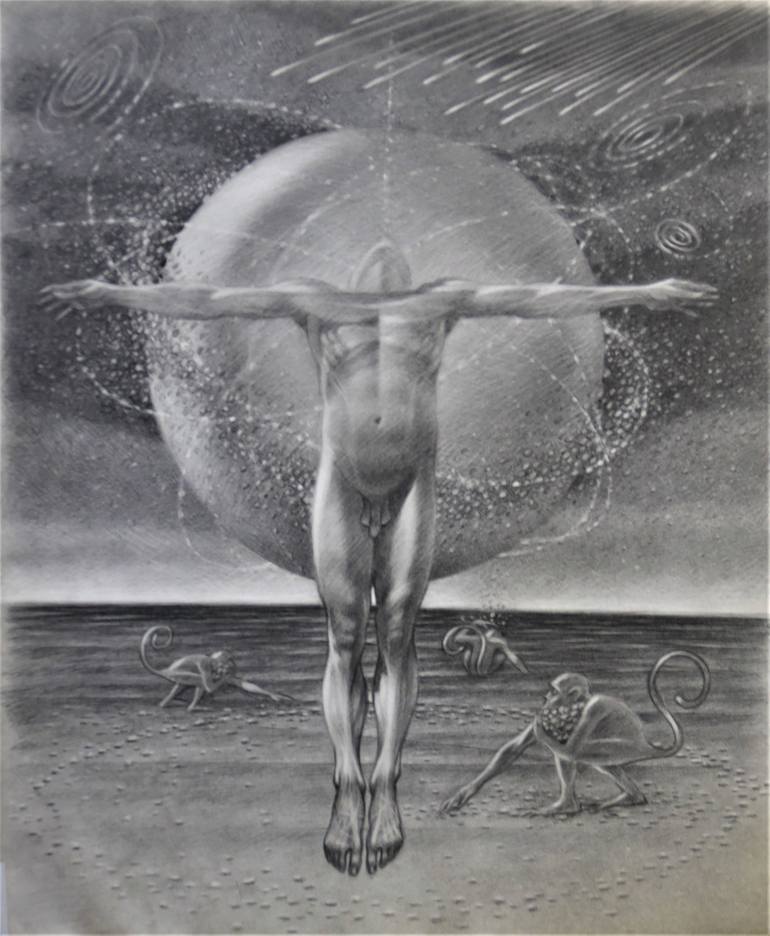


VIEW IN MY ROOM
Celestial Navigation - Time Fragment: 1389 Drawing
United States
Drawing, Graphite on Paper
Size: 14 W x 17 H x 1 D in
Ships in a Box
About The Artwork
Kosovo battle, year 1389 A.D. - Ottoman Invasion of Europe Plan of the battle: Serbian and Turkish accounts of the battle differ, making it difficult to reconstruct the course of events. It is believed that the battle commenced with Ottoman archers shooting at Serbian cavalry, who then made ready for the attack. After positioning in a wedge formation, the Serbian cavalry managed to break through the Ottoman left wing, but were not as successful against the center and the right wing. The Serbs had the initial advantage after their first charge, which significantly damaged the Ottoman wing commanded by Yakub Çelebi. When the knights' charge was finished, light Ottoman cavalry and light infantry counterattacked and the Serbian heavy armor became a disadvantage. In the center, Serbian troops managed to push back Ottoman forces, except for Bayezid's wing, which barely held off the Bosnians commanded by Vlatko Vuković. Vuković thus inflicted disproportionately heavy losses on the Ottomans. The Ottomans, in a ferocious counterattack led by Bayezid, pushed the Serbian forces back and then prevailed later in the day, routing the Serbian infantry. Both flanks still held, with Vuković's Bosnian troops drifting toward the center to compensate for the heavy losses inflicted on the Serbian infantry. Historical facts say that Vuk Branković saw that there was no hope for victory and fled to save as many men as he could after Lazar was captured. In traditional songs, however, it is said that he betrayed Lazar and left him to die in the middle of battle, rather than after Lazar was captured and the center suffered heavy losses. As the battle turned against the Serbs, it is said that one of their knights, later identified as Miloš Obilić, pretended to have deserted to the Ottoman forces. When brought before Murad, Obilić pulled out a hidden dagger and killed the Sultan by slashing him, after which the Sultan's bodyguards immediately killed him.
Details & Dimensions
Drawing:Graphite on Paper
Original:One-of-a-kind Artwork
Size:14 W x 17 H x 1 D in
Frame:Not Framed
Ready to Hang:No
Packaging:Ships in a Box
Shipping & Returns
Delivery Time:Typically 5-7 business days for domestic shipments, 10-14 business days for international shipments.
Handling:Ships in a box. Artists are responsible for packaging and adhering to Saatchi Art’s packaging guidelines.
Ships From:United States.
Have additional questions?
Please visit our help section or contact us.
United States
Born in Sabac, Serbia. Lives and works in New York City, United States. YouTube: "Cane Dojcilovic - Drawing and Visual Memory" http://www.canedojcilovic.portfoliobox.net/paintings http://www.canedojcilovic.portfoliobox.net/drawings. FRAGMENT FROM THE NOTEBOOK (3) “Process“ - Inspiration/Motivation (Internal/ External/ Technical) "...Inspiration is a human face or a body, but subject matter is inconsequential, it could be anything. Initial stage of the painting or drawing is calculated, calm and simple, with a clear subject matter. Fragmentation and chaos follows, sometimes only to lead right back to the calculated and calm beginning which would be, inevitably, fragmented again. Different “poetics” are developing in the process, intentionally or unintentionally dependent to the painting process itself. Few hours of painting today could take any direction tomorrow, either to more fragmentation and complication or to clearing and simplification of the fragmentation painted yesterday. Extremes of opposites, symbiosis of sharp and soft, stillness and motion, bright and dark and a range of different temperature grays in between are originating and becoming visible. All those opposites can find the balance only in the process of painting and they cannot be devised, formulated or arranged in advance. In that process, separate rhythms, “plays” and fragmentations of the forms, lights, shadows and structures are developing and starting to evolve and deviate to different directions, somehow becoming independent from the initial “subject” matter. It seems to me that there is never end to that process and in it I find the joy of painting that prevents me from declaring a painting “finished”. That is why my paintings are only in different stages, depending on where and when I decided to stop painting them. I am aware that rational decision must be made sooner or later: when to stop? But my paintings are never “finished"…"
Thousands Of Five-Star Reviews
We deliver world-class customer service to all of our art buyers.
Global Selection
Explore an unparalleled artwork selection by artists from around the world.
Satisfaction Guaranteed
Our 14-day satisfaction guarantee allows you to buy with confidence.
Support An Artist With Every Purchase
We pay our artists more on every sale than other galleries.
Need More Help?